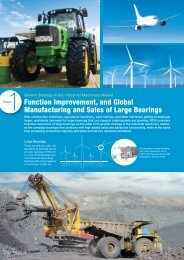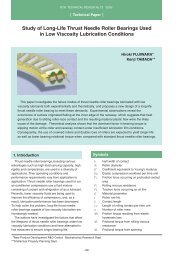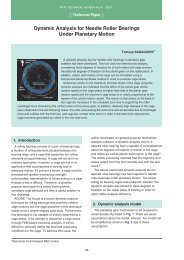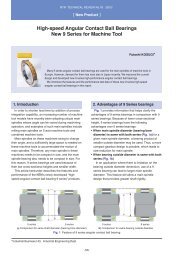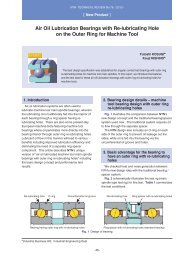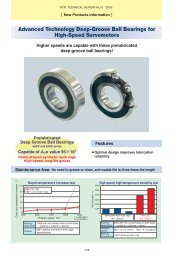Special Issue; Products for Industrial Machinery - NTN
Special Issue; Products for Industrial Machinery - NTN
Special Issue; Products for Industrial Machinery - NTN
Create successful ePaper yourself
Turn your PDF publications into a flip-book with our unique Google optimized e-Paper software.
<strong>NTN</strong> TECHNICAL REVIEW No.742006<br />
previously and illustrated in Fig.3(a). After 250 test<br />
hours, the measured amounts of base oil delivered are<br />
graphically plotted in Fig. 6.<br />
It can be understood that the amount of base oil<br />
delivery varies greatly depending on the type of<br />
grease used. Compared with Grease-A, the amount of<br />
base oil delivery with Grease-B was approximately 2<br />
times more than Grease-A. In other words, compared<br />
with Grease-A, Grease-B is more prone to base oil<br />
separation. The choice of a grease that is prone to<br />
base oil separation is one important consideration <strong>for</strong><br />
the authors’ new grease lubrication system.<br />
3.2 Base oil delivery mechanism<br />
As mentioned above, the factors that allow the<br />
authors’ novel grease lubrication system to be capable<br />
of base oil delivery include the heat cycle, optimized<br />
radial clearance and the choice of grease. The<br />
authors studied how these factors affect base oil<br />
delivery by measuring the pressure in the grease<br />
chamber in the base oil delivery mechanism. For the<br />
test, the base oil delivery model illustrated in Fig. 2<br />
Pressure kPa<br />
Pressure kPa<br />
50<br />
40<br />
30<br />
20<br />
10<br />
0<br />
-10<br />
-20<br />
-30<br />
-40<br />
-50<br />
(a)<br />
16<br />
12<br />
8<br />
4<br />
0 10 20 30 40 50 60 70 80<br />
30<br />
0<br />
20<br />
24 26 28 30<br />
-4<br />
15<br />
-8<br />
0.05 mm clearance 0.15 mm clearance 0.2 mm clearance<br />
0.45 mm clearance temperature<br />
Time h<br />
Pressure change history in grease chamber<br />
0.05 mm clearance 0.15 mm clearance 0.2 mm clearance<br />
0.45 mm clearance temperature<br />
(b)<br />
Time h<br />
Detailed pressure change<br />
Fig. 7 Pressure change history in grease chamber<br />
50<br />
40<br />
35<br />
25<br />
20<br />
45<br />
40<br />
35<br />
30<br />
25<br />
10<br />
Temperature ˚C Temperature ˚C<br />
was used, the pressure in the grease chamber was<br />
measured with a distortion gage pressure sensor and<br />
the grease temperature was determined with a<br />
thermocouple. The sizes of radial clearances adopted<br />
were 0.05 mm, 0.15 mm, 0.2 mm and 0.45 mm.<br />
Grease-B was prefilled in the grease chamber.<br />
The results of the grease chamber pressure measurements<br />
are summarized in Fig. 7(a). In addition,<br />
the temperature readings in the grease chamber<br />
obtained at the same time using the model with a<br />
radial clearance of 0.05 mm are also indicated. In the<br />
heat cycle pattern adopted, the lowest temperature<br />
was 38˚C and the highest temperature was 41˚C<br />
(temperature difference of 3˚C), and the cycle was<br />
repeated once every 2 hours. The pressure in the<br />
grease chamber kept at 38°C at the start of the test<br />
was taken as 0 kPa. Fig. 7(b) is a partial view of the<br />
measurement record shown in Fig. 7(a), with the time<br />
axis enlarged.<br />
From these diagrams, the following observations,<br />
which fulfill expectations, can be made about the<br />
grease chamber. First, the pressure increases as the<br />
temperature increases and the pressure drops as the<br />
temperature drops. Second, the pressure during<br />
temperature increase also correlates to the size of the<br />
radial clearance at the end point of the grease<br />
chamber. The pressure was greatest when the<br />
clearance was the smallest at 0.05 mm and<br />
decreased with greater clearance. Furthermore, the<br />
maximum pressure relative to the clearance of 0.05<br />
mm is approximately 10 kPa. The authors think that<br />
the pressure in the grease chamber readily increases<br />
with the smaller radial clearance due to better sealing<br />
of the interior of the grease chamber. They also<br />
conclude that the grease in the grease chamber<br />
expands as the temperature increases, causing the<br />
base oil and thickener in the grease to separate. Since<br />
the fluidity of the separated base oil is higher than the<br />
thickener, as the pressure in the grease chamber<br />
increases, the separated base oil is pushed out<br />
through the clearance. It appears that when delivery of<br />
the separated base oil through the clearance begins,<br />
the pressure in the grease chamber gradually<br />
decreases as shown in Fig. 7(b).<br />
Next, when the temperature of the grease drops,<br />
the grease begins to shrink, and as a result, the<br />
pressure in the grease chamber drops. While the<br />
pressure is dropping, the rate of base oil delivery from<br />
the clearance gradually decreases and a portion of the<br />
delivered base oil is drawn back into the clearance.<br />
Then, the interior of the grease chamber seems to be<br />
sealed due to the surface tension of the oil. This<br />
theory is further supported by the fact that the<br />
minimum pressure value is somewhat negative. The<br />
-12-


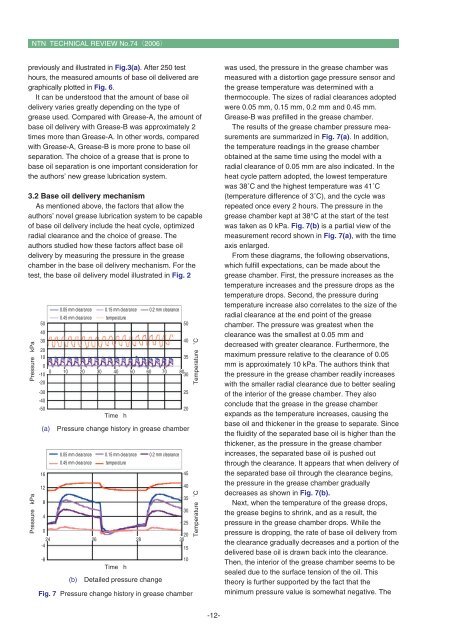
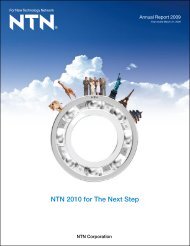
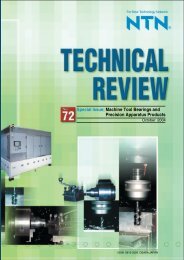
![[New Product] Unit Products for Office Equipment - NTN](https://img.yumpu.com/27154451/1/184x260/new-product-unit-products-for-office-equipment-ntn.jpg?quality=85)
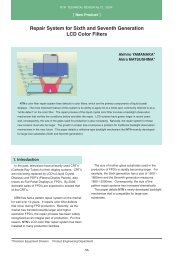
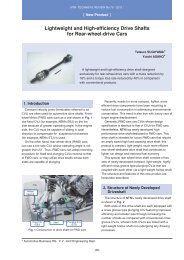
![[New Product] Development of Oil-impregnated Sintered ... - NTN](https://img.yumpu.com/27154427/1/184x260/new-product-development-of-oil-impregnated-sintered-ntn.jpg?quality=85)

